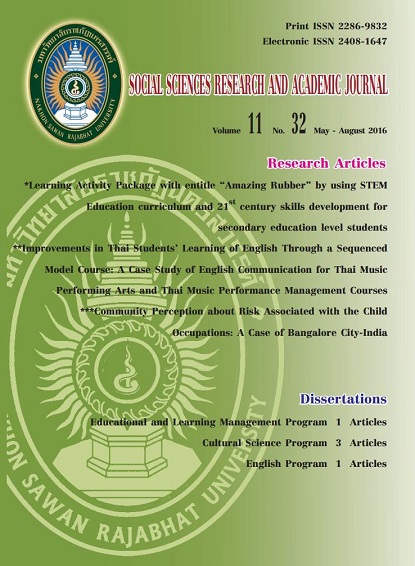The development of cultural learning resource models by using community participation: Nakha Sub-District, Wapipathum District, Maha Sarakham Province
Main Article Content
Abstract
Abstract
The aims of this research are 1) to study background, and 2) to study development models of cultural learning resources by suitable community participation. This was the research and development (R&D), which adopted the Action Learning (AL) and Participatory Action Research (PAR). Research instruments for collecting data were observation, interview, focus group discussion, before action review (BAR), after action review (AAR), workshop, and activity report. Research areas were: Bann Dongyang Village Moo 3, and Bann Namuang Village Moo 14, Nakha sub-district, Wapipathum district, Maha Sarakham province. Researching duration started from Jun 2012 to Jun 2014. Document analysis studied from involving document and field studied, and using the Analytic induction method. Purposive sampling method was used for sampling collecting, which was 70 people so that number included 20 people of key informants, 30 people of casual informants, and 20 people of general informants. The research results found were as the following:
1. The background and base area found that it had a long history, lifestyle the same as ordinary northeast people (Isan people), and the main occupation is doing rice farming. The development of cultural learning resource confederated with diversity groups of community participation. Encouragement and development were from all incessantly segments. As a consequence, the study center of Sufficiency Economy was established and rose to ten groups. The research areas has got interested in the cultural learning resource, because it brought the local wisdom to drive community activities.
2. The development models of cultural learning resource by community participation, so that created the development model by using a tentative conceptual model, also applied five processes of Action Leaning (AL), and six processes of Participatory Action Research (PAR). Those two approaches could create fourteen events of action learning activities, after that experimentation with the research areas. As a result of those activities, a new group: a cotton-weaving group was established as one more group from an original target group at Bann Namuang Village. Furthermore, fourteen of practical learning activities are increased to seventeen activities, which were a budget seeking activity and supporting sector, the activity of making a knowledge brochures, and creating a network of cultural activities.


